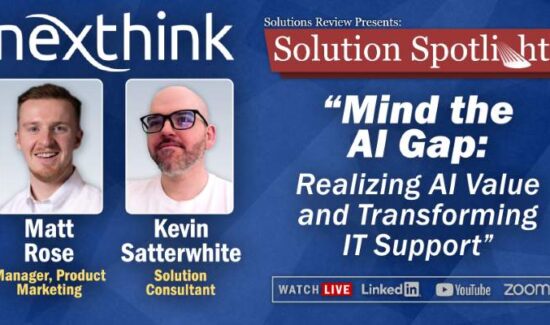15 of the Best AI Agents for Automation to Consider in 2025


The editors at Solutions Review are exploring the emerging AI application layer with this authoritative list of the best AI agents for automation efforts across business functions, departments, and processes.
The proliferation of generative AI has ushered in a new era of intelligent automation, and AI agents are at the forefront of this transformation. From embedded copilots that analyze spreadsheets to autonomous agents that browse the web, write code, and synthesize complex data across systems, AI agents are shaping and reshaping how forward-thinking organizations understand and act on information.
In this up-to-date and authoritative guide, our editors will spotlight some of the top AI agents and agent platforms available today for business automation, grouped into clear categories to help you find the right tool for your specific needs—whether you’re a developer looking to automate parts of your code, a business analyst who needs to streamline your data collection, or a manager who is prioritizing enterprise-scale AI adoption.
This resource is designed to help you:
- Understand what makes AI agents different from traditional automation tools
- Explore the capabilities and limitations of each available agent or agent platform in the marketplace
- Choose the best solution for your team based on use case, skill level, and scalability options
Note: This list of the best AI agents for automation was compiled through web research using advanced scraping techniques and generative AI tools. Solutions Review editors use a unique multi-prompt approach to employ targeted prompts to extract critical knowledge and optimize content for relevance and utility. Our editors also utilized Solutions Review’s weekly news distribution services to ensure the information is as close to real-time as possible. The list is organized in alphabetical order.
The Best AI Agents for Automation
Anthropic (Claude)
Use For: Anthropic’s Claude Code is an agentic tool designed to help developers delegate coding tasks to Claude.
Claude Code is powered by Claude 3.7 Sonnet, a hybrid reasoning model used for coding that can significantly improve a company’s content generation, data analysis, and business planning efforts. The system is particularly valuable for reducing development time on routine coding tasks, allowing developers to focus on higher-level design and architecture decisions.
Key Features:
- Turn anyone into an AI developer with Anthropic’s accessible docs and tooling.
- Analyze a company’s codebases with expert-level reasoning via Github integration.
- Generates unit tests and test cases to verify code functionality and edge cases.
- Creates code documentation for functions, classes, and modules based on their implementation.
Get Started: Claude Code can integrate directly with a company’s development environment to help them streamline their workflows without the need for additional servers or complex setups. It’s currently in beta as a research preview and will continue to evolve based on user feedback.
Gumloop
Use For: Gumloop allows users to build and launch custom AI tools and automate workflows with the power of AI without coding.
As a platform for building LLM-powered automations, Gumloop equips its users with ready-made components they can use to create advanced AI tasks for data extraction, web scraping, document processing, financial analysis, human resources, data scoring, and more. User data will remain untouched for AI training, as it is backed by comprehensive data processing agreements and state-of-the-art encryption, both at rest and during transmission.
Key Features:
- A Chrome extension makes it easy for users to develop no-code AI browser automations.
- Build complex workflows visually; if you can describe your workflow as a list of steps, Gumloop can automate it.
- Use OpenAI or Anthropic models instantly—no configuration required.
- Parallel flow execution allows users to run millions of nodes without restriction, enabling 10x the speed of competitors.
Get Started: Gumloop offers several models to provide each user or team with the capabilities they need to automate their work. The platform is growing rapidly—it started 2025 with a successful Series A funding round and has been releasing new features and updates for its toolset on a monthly basis.
LangChain
Use For: LangGraph, powered by LongChain, equips teams with control over custom agent and multi-agent workflows, seamless human-in-the-loop interactions, and native streaming support for enhanced agent reliability and execution.
The platform’s APIs make it easy for teams to craft agent-appropriate UXs and deploy their agents with purpose-built infrastructure. It aims to provide an “end-to-end developer experience” by simplifying the prototyping, debugging, and sharing of agents via the visual LangGraph Studio. Companies can then deploy their applications with 1-click deployments and monitor app performance with LangSmith.
Key Features:
- An extensive library of off-the-shelf tools and an intuitive framework enabling users to customize their own.
- Design diverse control flows—single, multi-agent, hierarchical, sequential—from one unified framework.
- Add human-in-the-loop functionalities to steer and approve agent actions.
- Expose, update, and rewind the app’s state for better user visibility, steering, and interaction.
Get Started: Where other agentic frameworks work for simple tasks but fall short for complex tasks, LangGraph aims to provide an expressive framework to handle unique tasks without restricting users to a single black-box cognitive architecture.
Microsoft AutoGen
Use For: AutoGen’s open-source programming framework provides a flexible framework for accelerating development and research on agentic AI systems.
While still in active development, Microsoft AutoGen can already enable conversational agents that work together with structured roles, communicate effectively, and leverage various tools and external resources. This makes them particularly useful for tasks that require different specializations or perspectives, like software development, data analysis, and complex reasoning.
Key Features:
- Agents communicate through asynchronous messages, supporting both event-driven and request/response interaction patterns.
- Users can design complex, distributed agent networks that operate across organizational boundaries.
- Built-in tools provide tracking, tracing, and debugging agent interactions and workflows.
- The robust, asynchronous, and event-driven architecture enables a broader range of agentic scenarios.
Get Started: The latest release, AutoGen v0.4, is available now and redesigned the AutoGen library with the goal of improving its code quality, robustness, generality, and the scalability of its agentic workflows.
OpenAI Operator
Use For: Using its own browser, OpenAI Operator can access the web and perform various tasks, including filling out forms, ordering groceries, and creating content.
Operator is one of OpenAI’s first agents and is powered by a new model called Computer-Using Agent (CUA). This model combines GPT-4o’s vision capabilities with advanced reasoning and reinforcement learning, enabling the agent to interact with graphical user interfaces (GUIs) in the same way that humans do.
Key Features:
- Take action on the web without requiring custom API integrations.
- Automated and human review processes continuously identify new threats and quickly update safeguards.
- Run multiple tasks simultaneously.
- Users can save prompts for quick access, which is ideal for automating repeated tasks.
Get Started: Operator is currently in a research preview mode and will continue to evolve based on user feedback. It’s available now for ChatGPT Pro users in the United States.
Stack AI
Use For: Build and deploy AI agents, automations, and other applications for multiple use cases within minutes.
The Stack AI platform leverages AI to help users and teams reduce manual work, accelerate information retrieval, and generate actionable insights. Some of the AI agents it can create include data warehouse, request-for-proposal (RFP) creation, physician co-pilots, and more. Businesses can deploy in the cloud or on-premises, which makes it an easy tool to integrate with their existing models and databases.
Key Features:
- Build AI agents with a code-free visual interface and deploy them with customizable UIs or ready-to-use API endpoints.
- SOC2, GDPR, HIPAA compliant platform capable of working with secure models like Azure, OpenAI, and AWS Bedrock.
- User data will not used for training AI models through data processing addendums (DPAs).
- Stack AI can be self-hosted on a company’s internal servers, giving them complete control over their data.
Get Started: Stack AI makes it easy for users of all experience levels to develop AI agents, custom user interfaces, and API endpoints. Businesses can sign up for a demo or consultation to see firsthand how the platform can be customized to their specific needs. It also offers several pricing models for businesses of various sizes and goals.



















